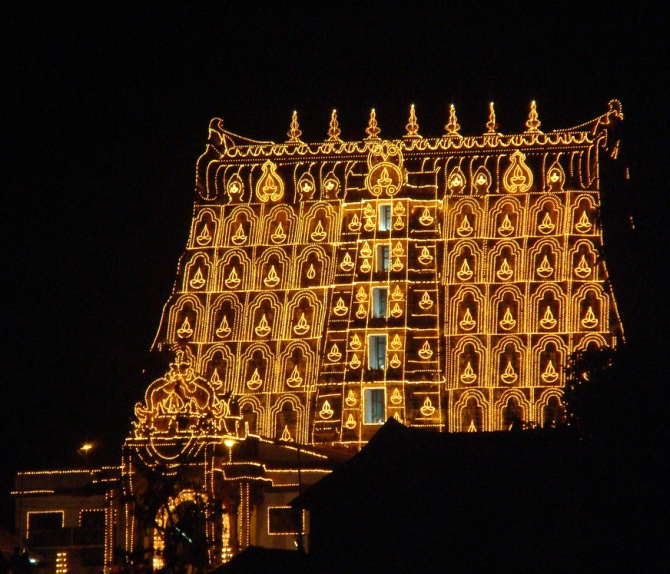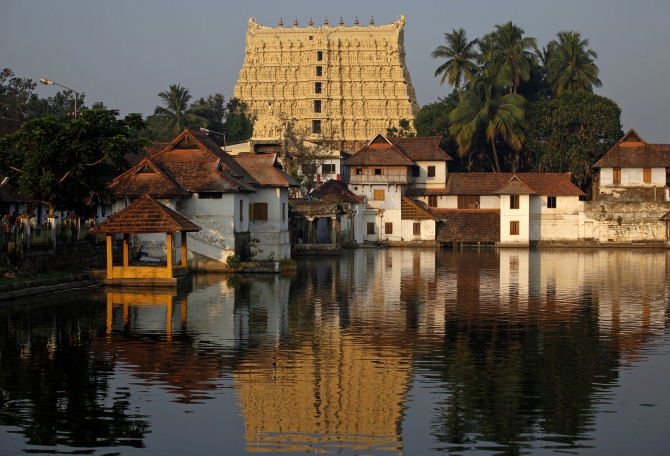
The interim order of the Supreme Court in the Sree Padmanabhaswamy Temple case that virtually de-controlled the shrine from the erstwhile Travancore royal family marks clean break from the past.
The apex court, while agreeing with the report of the amicus curiae Gopal Subramaniam, had on Thursday ordered the creation of a five-member administrative set-up under the district judge, which will not have any direct representation of the royal family.
The decision also signalled a critical turn in the long-drawn litigation for transparency in administration and proper audit of the huge treasures of the temple, started years back as a private petition in a local court.
Lord Padmanambha is the family deity of Travancore royal house and since 18th century the princes of the lineage had ruled most of south Kerala and adjoining parts of Tamil Nadu as "Padmanabhadasa" (servants of Padmanabha).
After the integration of the princely state in 1947, the royal rule came to an end and most major temples of Travancore were brought under a Devaswom Board.
But as a special case, control over the Padmanabhaswamy Temple was left in the hands of the royal family. Interestingly, the elected governments that came to power in the state since then, including those led by the Left, have bothered a little about the temple or the priceless treasures hidden in its vaults.
Though old-timers used to say about the 'maha nidhi' (fabulous treasure) in the underground chambers, the public at large had for long taken such claims as exaggerated.
…

Things started changing when two devotees approached a sub-court in Thiruvananthapuaram in 2007 seeking to restrain the temple authorities from opening the chambers and photographing the treasures for making an album.
Considering the plea, the court appointed a two-member lawyers' commission vesting them with the authority to open a particular chamber to take out jewels and utensils required for festivals and other important occasions.
The court also suggested creation of an administrative body on the lines of the Guruvayur Temple, which was challenged in the high court by the temple authorities. It was at this juncture that T P Sunarrajan, a former Indian Public Service officer, stepped in with the argument that the temple is no longer a private property and there should be accountability and transparency in its management.
Sundararajan's stand was endorsed by the high court and suggested that temple administration be brought under a trust or a separate body formed for it. This was challenged by the royal family in the Supreme Court where it is pending for final order.
The temple, however, drew international media glare with the apex court ordering the inventory of the riches stashed away in its chambers in 2011.
What the inventory team, which comprised among others two retired judges of the high court, found in the vaults was mind-boggling.
For days that followed, the media, though kept out from the exercise, came out with stories of huge piles of gold coins, jewelry, stone-studded articles and gold and silver vessels being found in the chambers.
…

In a sad turn to the course of events, Sundar Rajan died a few months later but the struggle he initiated for protection of the temple wealth continued.
The temple case took a critical turn with the amicus curiae submitting a voluminous report running into over 500 pages in which be brought out serious irregularities and malpractices in the management of the temple and its immense wealth.
The report even suggested that there had been attempts to take out certain quantity of the temple gold allegedly with the connivance of the management.
While accepting the apex court order which brought to an end the control of the temple by the royal family, the Congress-led United Democratic Front government has made it clear that certain ritualistic rights of the royal house would continue.
Reacting to the judgment, Chief Minister Minister Oommen Chandy also criticised the tendency of certain quarters to denigrate the royal family.
According to Chandy, the very fact that these huge treasures have been preserved itself is proof to their faith and commitment. The government would immediately taking measures to further improve the security of the temple.
The sprawling temple, an architectural splendor in granite, was renovated in its present form in the 18th century by Anizham Tirunal Marthanda Varma.
A revered figure in local history, Marthanda Varma quelled the rebellion of Nair chieftains who wanted to usurp power by installing a puppet in the throne.
After reinforcing his position as the legitimate heir of the royal house that follow matrilineal succession, Marthanda Varma expanded his principality through diplomatic and military means to cover much of south Kerala, stretching from Kanyakumari in Tamil Nadu, to Paravur near Kochi.